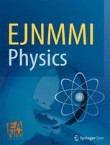We offer a free open access support service to make it easier for you to discover and apply for article-processing charge (APC) funding. Learn more here.
Aims and scope
EJNMMI Physics is an international platform for scientists, users and adopters of nuclear medicine with a particular interest in physics matters. As a companion journal to the European Journal of Nuclear Medicine and Molecular Imaging, this journal has a multi-disciplinary approach and welcomes original materials and studies with a focus on applied physics and mathematics as well as imaging systems engineering and prototyping in nuclear medicine. This includes physics-driven approaches or algorithms supported by physics that foster early clinical adoption of nuclear medicine imaging and therapy.
EJNMMI Physics publishes original research articles, reviews, case reports, commentaries, and short communications, as well as article types with unique submission criteria, Young Investigator Articles and Teaching Files.
Young Investigator Articles: This category is reserved for young scientists in the course of their MSc or PhD studies who wish to present part of their undergraduate and graduate research in a scientific framework. Manuscripts should follow the structure of an original research submission, however, the content may be comprised of several sub-projects. Typically, young investigator reports entail a scientifically sound summary report of a short-term project or a PhD thesis.
Teaching Files: This category is reserved for manuscripts that aim at educating the readership on an important or common application of physics in nuclear medicine imaging and therapy. To introduce, explain, detail and summarise an observation, process, workflow related to the physics of nuclear medicine or hybrid imaging. The same trail of educational thoughts may be applicable to methodologies and applications of physics in nuclear medicine, e.g. image-guided dosimetry.
Articles
-
-
Estimation of kidney doses from [177Lu]Lu-DOTA-TATE PRRT using single time point post-treatment SPECT/CT
-
Multi-modal co-learning with attention mechanism for head and neck tumor segmentation on 18FDG PET-CT
-
Artificial intelligence-based joint attenuation and scatter correction strategies for multi-tracer total-body PET
-
A review of 177Lu dosimetry workflows: how to reduce the imaging workloads?
-
State of the art in total body PET
-
Recent developments in time-of-flight PET
-
An overview of CEST MRI for non-MR physicists
-
EANM Dosimetry Committee series on standard operational procedures for internal dosimetry for 131I mIBG treatment of neuroendocrine tumours
-
Physics of pure and non-pure positron emitters for PET: a review and a discussion
Need help with APC funding?
Check if your institution is a member
More than 500 institutions have partnered with BMC through the membership program. As an affiliated Author from a member institution, you may be entitled to submit your manuscript without paying the article processing charge (APC) or with a discount. Check here if your institution is a member!
EJNMMI Physics - Kindly explore our collections here
Topical Collections about latest and interesting topics in EJNMMI Physics are available at: https://ejnmmiphys.springeropen.com/idrt
EJNMMI Physics aims to publish new research in nuclear medicine physics and related matters. It addresses research in nuclear medicine physics, dosimetry, reconstruction and instrumentation. It welcomes original studies with a focus on applied physics and mathematics as well as imaging systems engineering and prototyping in nuclear medicine. This includes physics-driven approaches or algorithms supported by physics that foster early clinical adoption of nuclear medicine imaging and therapy. The open access model leads to fast distribution and wide distribution of new scientific results. Manuscripts are accepted for publication only after thorough peer review.
This journal has been launched by Springer and is a companion journal to the EJNMMI family. Authors of papers with a focus on nuclear medicine physics, whose manuscript despite high quality is not accepted in the mother journal can submit to this daughter journal. Besides regular papers the journal gives the possibility to publish reviews, educational papers guidelines and short communications.
By this combination of different articles, I hope to establish a unique platform for nuclear medicine physics related research.
Stefaan Vandenberghe, Editor-in-Chief, Ghent University
The EJNMMI Journal Family and EANM Springer Award
Highlights of our featured content and the latest developments from the EJNMMI group of journals can be found on the EJNMMI Journal Family webpage. There you will also find details about the annual EANM Springer Prize.
Annual Journal Metrics
-
Citation Impact 2023
Journal Impact Factor: 3.0
5-year Journal Impact Factor: 3.7
Source Normalized Impact per Paper (SNIP): 1.141
SCImago Journal Rank (SJR): 1.243Speed 2023
Submission to first editorial decision (median days): 23
Submission to acceptance (median days): 149Usage 2023
Downloads: 449,199
Altmetric mentions: 94
Follow
- ISSN: 2197-7364 (electronic)
